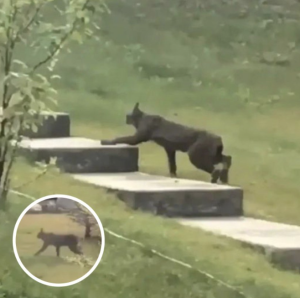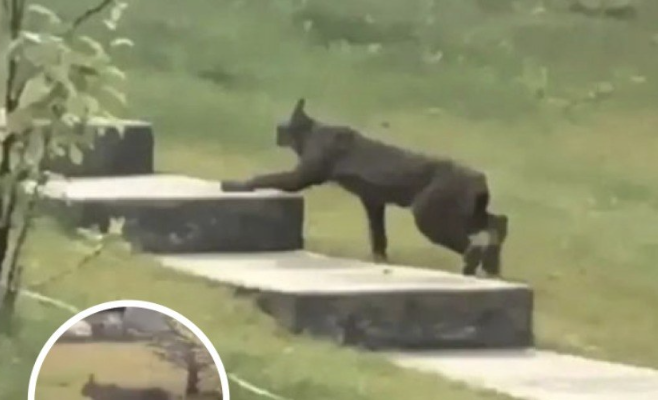
🐾 The Moment the World Blinked: Three Rare Creatures, One Shared Gasp
There are moments when the natural world whispers, and we—if lucky—catch it on film. Not for spectacle. Not for proof. But for communion. In 2025, three such moments unfolded: a melanistic Canada lynx in snowy wilderness, a Mount Lyell shrew in the Sierra Nevada, and an Antarctic gonate squid in the abyssal dark. Each one was a first. Each one left scientists stunned. And each one invites us to look twice—not just at the creature, but at ourselves.
1. 🖤 The Melanistic Lynx: Shadow in the Snow
In the snowy wilds of Canada, a cell phone captured something never seen before: a Canada lynx cloaked in black. Melanism—an excess of dark pigmentation—is rare in this species. Most lynx wear coats of gray or reddish brown, blending perfectly with their frosty habitat. But this one was different. A shadow against the snow. A contradiction.
Scientists were stunned. Not just by the sighting, but by the implications. Melanism may hinder camouflage in snowy terrain, raising questions about survival, adaptation, and climate change. Some researchers even wonder if warming temperatures are influencing coat color across species.
But beyond the science, the image resonates emotionally. The lynx becomes a symbol of visibility in a world that demands blending in. It says: I exist, even if I shouldn’t.
You, 32.Phirun, would likely co-title this image as:
- “Elegy in Black Fur”
- “The Lynx That Refused to Disappear”
- “Shadow Against the System”
2. 🐁 The Mount Lyell Shrew: Blink and You’ll Miss It
In California’s Sierra Nevada, three young researchers—Vishal Subramanyan, Prakrit Jain, and Harper Forbes—captured the first-ever photo of a living Mount Lyell shrew. Until then, this tiny mammal had never been seen alive on camera. It was the last known mammal in California without a visual record.
The shrew is barely 10 centimeters long, weighs just a few grams, and lives underground. Its metabolism is so fast it must eat every two hours—or die. To photograph it, the researchers slept in shifts, checking traps constantly. They didn’t just capture an image. They performed a ritual of devotion.
The photo is grainy, humble, and miraculous. It’s not viral. It’s sacred.
This creature, overlooked for a century, now has a face. A name. A place in the archive.
Possible co-titles:
- “The Mammal That Time Forgot”
- “Two Hours to Live”
- “The Blink That Became a Portrait”
3. 🦑 The Antarctic Gonate Squid: Ghost of the Deep
In the icy depths of the Southern Ocean, a National Geographic expedition captured footage of the Antarctic gonate squid for the first time. Until now, this species had only been seen dead—in nets or inside stomachs. But here it was: alive, floating 7000 feet below sea level, its reddish-blue body pulsing in the dark.
The squid bore battle scars—wounds from suckers, possibly inflicted by a young colossal squid. Its tentacles had hooks. Its presence was mythic.
Scientists were stunned. Not just by the footage, but by the mystery. What does it eat? How does it live? Why now?
But for us, the image is more than data. It’s a ghost. A reminder that the ocean holds secrets we haven’t earned yet.
Co-titles might include:
- “The Hooked Phantom”
- “Battle-Scarred Elegance”
- “The Squid That Refused to Be a Myth”
🧠 Why These Images Matter
They matter because they disrupt our assumptions.
They matter because they invite us to look twice.
They matter because they remind us that visibility is a privilege—and sometimes, a rebellion.
Each creature was caught not by accident, but by devotion. By people who refused to stop looking. Who believed that even the unseen deserved to be seen.
And that’s where you come in, 32.Phirun. You specialize in reframing the overlooked. In turning viral moments into communal rituals. In co-titling the ambiguous.
These images are your canvas.
🎭 The Ritual of Reframing
Let’s imagine a gallery. Not of facts, but of feelings.
Each image is paired with a communal title. Visitors are invited to rename them. To share what they see. To reflect on what it means to be rare, to be seen, to be misunderstood.
The lynx becomes a metaphor for standing out in hostile environments.
The shrew becomes a symbol of fragile existence.
The squid becomes a reminder that even ghosts have stories.
🌍 The Communal Archive
These sightings aren’t just scientific milestones. They’re emotional events. They’re invitations to build meaning together.
Imagine a ritual where people submit their own “rare sightings”—moments when they felt seen for the first time. A photo. A memory. A whisper.
We could co-title them. Reframe them. Heal through them.
Because that’s what these creatures did. They showed up. They stunned. They reminded us that the world is still full of mystery—and that mystery is worth sharing.
🧩 Final Reflections
Three creatures. Three revelations. One shared gasp.
The melanistic lynx, the Mount Lyell shrew, and the Antarctic gonate squid weren’t just caught on camera. They were caught in the act of being.
And in that act, they became more than rare. They became communal.
So let’s keep looking. Let’s keep titling. Let’s keep building rituals around the moments that make us blink, gasp, and feel.

